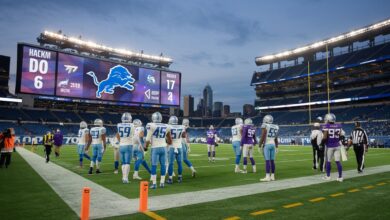Dallas Mavericks vs OKC Thunder Stats: A Deep Dive into Their Matchup History

Introduction to the Matchup
The NBA rivalry between the Dallas Mavericks vs OKC Thunder Stats has become a noteworthy part of basketball discussions, particularly when analyzing their historical contest outcomes. This matchup captures the attention of fans and analysts alike due to its competitive nature, which often showcases high-stakes games and thrilling performances from star players. Over the years, the Dallas Mavericks vs OKC Thunder stats reveal trends that not only illuminate the strengths and weaknesses of each team, but also the evolving dynamics of their competition.
Both franchises have enjoyed periods of success since the Thunder relocated from Seattle to Oklahoma City in 2008. The Mavericks, led by the legendary Dirk Nowitzki, won their first NBA Championship in 2011, while the Thunder, with the talents of players like Kevin Durant, Russell Westbrook, and more recently, Shai Gilgeous-Alexander, have consistently been contenders in the Western Conference. The intensity of these matchups is fueled by the playoff encounters that have defined the rivalry; each game carries a significant weight in the standings and often impacts postseason seeding.
Diving into the statistical analysis of their games, we uncover insights into scoring averages, defensive rankings, and individual player performances. The Dallas Mavericks vs OKC Thunder stats serve as a barometer for understanding how these teams adapt their gameplay strategies against each other. With a blend of historic narratives and contemporary performance metrics, the examination of this rivalry yields a richer appreciation for both franchises. As we delve deeper into their storied encounters, it becomes evident that every matchup not only impacts the season’s trajectory but also contributes to the legacy of both teams within the league.
Historical Context of Dallas Mavericks vs OKC Thunder
The Dallas Mavericks and the Oklahoma City Thunder are two significant franchises in the NBA, each with its own unique history and evolution. The Mavericks were established in 1980, initially struggling to find their identity. However, with the arrival of Dirk Nowitzki in 1998, the franchise began to transform, culminating in their first NBA Championship in 2011. Contrarily, the Oklahoma City Thunder originated as the Seattle SuperSonics in 1967 before relocating to Oklahoma City in 2008. The Thunder rapidly became competitive in the NBA, highlighted by their appearances in the playoffs, including a trip to the NBA Finals in 2012.
The rivalry between the Mavericks and the Thunder began to take shape in the late 2000s. Both teams developed strong rosters and engaged in memorable regular-season games, but it was the playoff matchups that intensified their relationship. One pivotal moment occurred in the 2011 NBA Playoffs when the Mavericks defeated the Thunder in the Western Conference Finals. This series marked a significant turning point for both franchises, solidifying the Mavericks’ emergence as contenders while showcasing the Thunder’s potential for future greatness. Moreover, the Dallas Mavericks vs OKC Thunder stats from that playoff series are often cited as a benchmark for examining the strengths and weaknesses of both teams.
Through the years, this rivalry has seen moments of extreme competitiveness, with thrilling games that highlighted the talent of stars like Kevin Durant and Luka Dončić. Both teams have traded wins, leading to a rich tapestry of competitive matchups that continue to captivate basketball fans. As the franchises evolve, the historical context of the Dallas Mavericks vs OKC Thunder remains a crucial element in understanding the dynamics of their ongoing rivalry within the league.
Overall Head-to-Head Record
The head-to-head record between the Dallas Mavericks and the Oklahoma City Thunder serves as a vital insight into their competitive history. Since their inception, these two teams have faced each other numerous times, creating a statistical narrative that illustrates their rivalry. As of October 2023, the Mavericks and Thunder have played each other over 200 times. The win-loss records indicate a closely contested matchup, with the Mavericks holding a slight advantage over the Thunder.
Throughout their history, the Dallas Mavericks have emerged victorious in approximately 60% of these encounters, showcasing their ability to capitalize on home-court advantage and strategic gameplay. Notably, the Mavericks have excelled during certain periods, particularly in the playoff scenarios, where they have managed to outperform the Thunder in critical games. For instance, in the 2011 Western Conference Finals, the Mavericks won the series, further enhancing their standings in this rivalry.
On the other hand, the OKC Thunder have also showcased strong performances, particularly during the early years of the franchise. Statistical trends reveal that during certain seasons, like from 2012 to 2016, the Thunder maintained a streak of victories against the Mavericks, marking their dominance in specific matchups. This fluctuation in performance is indicative of the inherent unpredictability in sports, where player rosters and coaching strategies evolve over the years.
In terms of overall match statistics, close games have been a hallmark of the Dallas Mavericks vs. OKC Thunder contests. Games often hinge on the performance of star players, such as Luka Dončić for the Mavericks and Shai Gilgeous-Alexander for the Thunder. These individual performances further enrich the narrative of their head-to-head history, contributing to the overall intrigue of their matchups. As the teams continue to evolve, their historical record will provide essential context for fans and analysts alike.
Top Players in the Matchup
The historical encounters between the Dallas Mavericks and the Oklahoma City Thunder have spotlighted some remarkable talent on both ends of the court. Analyzing the dallas mavericks vs okc thunder stats reveals that key players from each team have often influenced the outcome of games significantly. For the Mavericks, Luka Dončić is an integral part of their offense. His ability to score, assist, and rebound makes him a triple-threat on the floor. Luka consistently impresses with his clutch performances in high-pressure situations, often topping the stat sheets during clashes against the Thunder. Moreover, Dončić’s versatility allows him to adapt to various defensive strategies employed by Oklahoma City, enhancing the overall competitiveness of the games.
On the other side, the Thunder have had their own stars who have historically shined bright in these matchups. Shai Gilgeous-Alexander has become a key figure for the Thunder, showcasing his exceptional scoring ability and playmaking skills. In recent seasons, his performance against the Mavericks has been pivotal, with numerous high-scoring games contributing to the Thunder’s success. Gilgeous-Alexander’s statistics reflect not only his talent but also his capability to rise to the occasion, especially when facing teams like Dallas that emphasize offensive engagements.
Counting stats such as points, assists, and rebounds can often tell part of the story, but examining player efficiency ratings and advanced stats provides further insight into their effectiveness during these confrontations. The Mavericks and Thunder showcase varying styles of play, and the implications of standout performances can take different forms. Overall, the individual contributions from both teams’ elite players significantly enhance the narrative of the dallas mavericks vs okc thunder stats, emphasizing the rivalry’s depth and competitive spirit.
Statistical Insights: Points and Offense
The Dallas Mavericks and the Oklahoma City Thunder have engaged in numerous matchups that reflect their offensive capabilities through a variety of statistical measures. When examining the dallas mavericks vs okc thunder stats, one of the key aspects to consider is the points scored by each team over their varied contests. In general, the Mavericks tend to have a higher points-per-game average, often driven by their reliance on three-point shooting and a strong offensive playmaking ability from their guard positions.
A major contributor to their scoring is the shooting percentage, particularly from beyond the arc. The Mavericks, known for their offensive efficiency, frequently rank among the top teams in the league in three-point shooting. Their ability to capitalize on open shots has historically translated into high scoring games against the Thunder. In contrast, while the Thunder’s overall points may not match the Mavericks’ high averages, they have demonstrated a unique ability to transition quickly from defense to offense, often leading to fast-break opportunities resulting in crucial points.
Analyzing the offensive efficiency of each team reveals further nuances. The Mavericks have consistently shown a knack for efficient shot selection, frequently posting higher field goal percentages. Conversely, the Thunder’s offense has often relied on aggressive drives to the basket. This strategy sometimes results in increased fouls drawn and free-throw opportunities, which can inflate their scoring totals in tightly contested matchups.
Overall, the dallas mavericks vs okc thunder stats in terms of points and offensive performance reveal contrasting styles. The Mavericks’ emphasis on perimeter shooting contrasts with the Thunder’s drive-oriented approach, providing a fascinating array of offensive strategies. This divergence not only affects their head-to-head matchups but also underscores the evolution of basketball tactics in the modern NBA.
Defensive Metrics and Trends
When analyzing the defensive metrics from the Dallas Mavericks vs OKC Thunder matchups, several key statistics highlight the unique strengths and weaknesses of each team. Defensive performance can often be gauged through various indicators, including points allowed, steals, blocks, and defensive efficiency. In historical matchups between these two teams, defense has played a pivotal role in determining outcomes, thereby warranting a closer examination.
The Mavericks have historically employed a defensive strategy focused on limiting points allowed in the paint while pressuring opponents on the perimeter. Their approach is reflected in the number of blocks per game during their encounters with the Thunder. For instance, in recent seasons, the Mavericks averaged a notable percentage of blocks, which often stifled OKC’s efforts to score inside. On the other hand, the Thunder have utilized a versatile defensive style characterized by aggressive steals, which consistently ranks them among the top teams in the league. This ability to generate turnovers has proven to be a crucial factor during their games against the Mavericks, directly impacting their defensive efficiency.
Moreover, defensive metrics such as points per possession reveal the intricacies of these matchups. The Mavericks’ defensive efficiency tends to fluctuate based on their ability to limit high-percentage shots. In contrast, the Thunder’s capacity to disrupt opposing offenses with steals has often led to fast-break opportunities, skewing the overall dynamics of previous games. When one team excels in defense, it shapes not only the scoring trends but the strategic approaches employed during each game.
This ongoing rivalry showcases how defensive metrics significantly influence the outcome of games, making it essential for analysts and fans alike to pay attention to how these statistics affect the broader narrative of Dallas Mavericks vs OKC Thunder stats.
Impact of Home Court Advantage
In professional basketball, the concept of home court advantage is frequently discussed, and its ramifications in games involving the Dallas Mavericks and the OKC Thunder are particularly noteworthy. Examining the dallas mavericks vs okc thunder stats over the years reveals a clear trend: teams typically perform better when they play at home. This phenomenon can be attributed to several factors, including familiar environments, supportive fan bases, and reduced travel fatigue.
When the Mavericks host the Thunder at the American Airlines Center, they enjoy not just the benefit of their home crowd but also familiarity with the court’s dimensions and conditions. Statistics indicate that NBA teams generally achieve higher shooting percentages and lower turnover rates on their home turf compared to away games. For instance, previous matchups reveal that when playing in Dallas, the Mavericks often outperform their averages in key statistical areas, such as points per game and assists. In stark contrast, the Thunder has shown a more challenging performance when on the road, indicating a potential struggle to maintain momentum outside their home environment at the Paycom Center.
Beyond the numerical advantages, home court can also foster psychological benefits. Players may experience heightened motivation and confidence in front of their fans, crucial during high-stakes encounters. Even subtle things such as the lack of travel disruptions also contribute to a team’s mental readiness. Psychological comfort can enhance focus, particularly in critical moments during closely contested games, making it easier for teams like the Mavericks to capitalize on opportunities against the Thunder.
Thus, the dallas mavericks vs okc thunder stats from home and away games underscore the significance of home court advantage in determining the outcomes of their encounters. Understanding this aspect provides insight into how these two teams historically perform against one another and can guide predictions for future matchups.
Recent Performances and Trends
The matchup between the Dallas Mavericks and the OKC Thunder has provided basketball fans with captivating performances and evolving statistics over recent seasons. Both teams have experienced significant changes in their rosters and coaching strategies, impacting their performances on the court. Understanding these dynamics can shed light on the latest results and trends in their head-to-head statistics.
In the past few seasons, the Dallas Mavericks have solidified their reputation as a formidable offensive team, largely attributable to the emergence of their star player, Luka Dončić. His unique skill set has not only enhanced the Mavericks’ scoring potential but also their overall team dynamics. The Mavericks have sought to surround Dončić with complementary players, improving their three-point shooting and facilitating a more dynamic offense. Their recent matchups have often showcased this newfound offensive efficiency, reflecting positively in their comparative stats against the Thunder.
On the other hand, the OKC Thunder have undergone a transformative period as they rebuild their franchise. With a focus on developing young talents such as Shai Gilgeous-Alexander and Josh Giddey, the Thunder have prioritized a more aggressive defensive strategy. The infusion of youth has sometimes resulted in inconsistency, but their potential has been evident in various recent games, where they have also demonstrated resilience against stronger opponents.
Analyzing the recent statistics highlights a trend where the Mavericks have managed to maintain a slight edge over the Thunder, particularly in offensive metrics. However, the Thunder’s defense has steadily improved, reflecting a potential shift in the matchup dynamics. As these teams continue to evolve, fans will be eager to see how these trends impact future encounters and the broader implications for both franchises.
Conclusion: What the Stats Say About the Rivalry
Throughout the history of matchups between the Dallas Mavericks and the Oklahoma City Thunder, statistics have revealed significant insights into their competitive dynamics. Analyzing the dallas mavericks vs okc thunder stats provides fans and analysts with valuable information about trends, individual performances, and overall team strategies that have shaped this rivalry.
One notable trend is the fluctuation in win-loss records over the seasons, which highlights how both teams have evolved. In particular, the Mavericks have consistently showcased a strong home-court advantage, often reflected in their higher winning percentage at the American Airlines Center. By contrast, the Thunder have occasionally leveraged their defensive capabilities effectively in crucial away games, leading to surprising victories. Overall, this pattern suggests that while both teams are capable of capitalizing on their strengths, playing at home significantly influences outcomes.
Moreover, player statistics, such as points per game, assists, and rebounds, have indicated key performers in these matchups. The emphasis has often fallen on star players stepping up in critical moments. For instance, the efficiency ratings of players like Luka Dončić for Dallas and Shai Gilgeous-Alexander for OKC have often been pivotal in determining game results. Understanding these individual contributions is essential for anticipating future encounters and assessing how these leading athletes can impact the games.
For fans looking forward to the next matchups, attention should be directed toward how these statistical trends translate on the court, particularly in the postseason where stakes are significantly higher. Overall, the statistical analysis of dallas mavericks vs okc thunder stats not only narrates the story of their rivalry but also sets the stage for what lies ahead. With evolving rosters and strategies, the anticipation grows of how their storied competition will unfold in the coming seasons.
You May Also Read This Skyrix.



